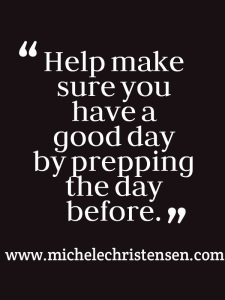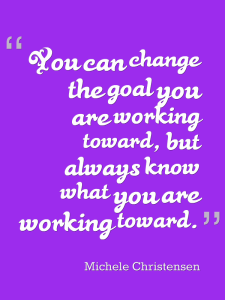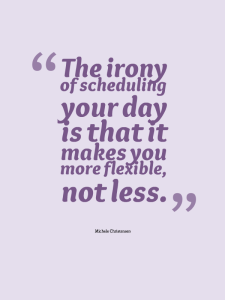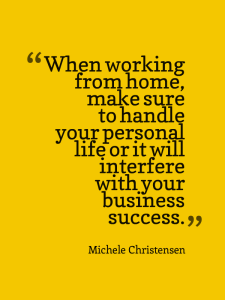Here’s a post I wrote for Karen May Dy’s Social Media Marketing blog on strategy, business and social media. I’d love to know what you think about it!
Tag: productivity
Begin your day the night before
 One of the biggest factors in whether or not I have an enjoyable, productive day is how I end the day before. As a solopreneur, your personal life and business life tend to blend together, so some of these ideas relate to non-work things.
One of the biggest factors in whether or not I have an enjoyable, productive day is how I end the day before. As a solopreneur, your personal life and business life tend to blend together, so some of these ideas relate to non-work things.

Do a little planning
One of my biggest productivity killers is staring at my to-do list and trying to figure out what to work on before I’ve even gotten anything done. I have a hard time getting into gear when I have to wade through dozens of tasks just to figure out what to do before I can even do anything. To combat this, I get my tasks and priorities lined up the night before. It’s the last work item I tackle for the day, so at whatever time I decide to quit for the day I spend 5-10 minutes making sure I can hit the ground running the next day.
Know when to quit
As a solopreneur, you to-do list is massive and never-ending. You’ll never get it all done, so a big part of your time management has to be deciding what doesn’t get done. Part of this is knowing when to stop working for the day. Quite literally, you could be up all night and not get it all done or even feel on top of things, so it’s important to have a set time at which you stop working. When I work in the evenings I try to make sure I have a set quitting time that gives me time to end my day, relax and get to bed on time.
Park on a downhill slope
This means that you leave your work in a condition that makes restarting easy. In the time leading up to quitting time, try to find a good place to stop. If there is no good place to stop, make sure to leave yourself some notes so you can jump back in without figuring out where you were. You’d be surprised how much you can forget in one day, and spending 30 seconds leaving yourself well-positioned to restart can save many minutes of headaches later.
Have an end-of-day routine
Make a short list of what you need to do at the end of the day to start your next day off right. Once you’ve wrapped up work, consider what personal chores would make your next morning run smoothly. I like to set up my coffee the night before, and sometimes I set up a load of laundry so I can start it as soon as I get up. You might want to pack your lunch, lay out your clothes or pack your bag for an early meeting. Doing these tasks the day before can help you have less-hassled morning.
Sketch out a schedule
Be sure to peek at your schedule for the next day so you’re not caught unaware of an early obligation. Create a rough outline of what you’ll be working on during which time windows. You can always change your mind, but having a plan gives you something to work from.
What else?
What do you do at the end of the day to ensure a strong start to the next day? Share it in the comments.
How to stay on track
 Someone asked me a question recently, and I thought it was such a great one that I decided to answer it here. I was at a training, and when I mentioned that I coached entrepreneurs, the person I was talking to asked me “How do you keep them on track? Entrepreneurs, myself included, are always changing gears.”
Someone asked me a question recently, and I thought it was such a great one that I decided to answer it here. I was at a training, and when I mentioned that I coached entrepreneurs, the person I was talking to asked me “How do you keep them on track? Entrepreneurs, myself included, are always changing gears.”
It’s a great question because he’s right – entrepreneurs are naturally drawn to new ideas and possibilities – bright, shiny objects anyone? Enthusiasm for new ideas is one of an entrepreneur’s greatest gifts and also one of the greatest challenges. Nobody goes into business with the desire to be bored.
Let me share a little of my philosophy first – I don’t “keep” people on track, because that implies force or power and I don’t believe entrepreneurs want or need that. Entrepreneurs are naturally motivated and love results, so guidance and perspective are better tools than force for entrepreneurs.
What I do is help business owners get clear on what they want to accomplish and how to get there. As they move forward, we tackle roadblocks together. When the inevitable “next big thing” pops up, I remind them of where they said they wanted to go and we assess if this new thing fits into that goal. If it does, we figure out how to fit it into the current plan. If it doesn’t, we talk about whether or not the original goal still fits. The beauty of running your own business is that you get to decide what the goals are and when to change them.
A word of caution – if you change your goals too often, you may end up never reaching them. I think this is one of the biggest hurdles entrepreneurs face – being able to stay with something after it gets boring but before it produces results. Most new projects go through the “darkest before the dawn” phase where the newness has worn off and finishing the project becomes a slog through tedium to get to the finish line. This is the worst time to give up – when completion is just around the corner.
This is a great example of how strategy and planning in a business pay off. If you start with a goal and a plan to get there, you have a criteria against which to weigh any potential new ideas. If the new idea fits, then use it. If it doesn’t, you have the option of changing your goal or your plan but do it intentionally and not because you got bored.
How to schedule your day for flexibility and productivity
 In my last post, I talked about how to keep your personal life from getting in the way of your business success. This post is about how to schedule your day to accommodate both business and personal tasks while being flexible and productive.
In my last post, I talked about how to keep your personal life from getting in the way of your business success. This post is about how to schedule your day to accommodate both business and personal tasks while being flexible and productive.
First, it’s important to commit to a practice of scheduling your day, so let me explain some of the benefits. You’ll be able to get a clear view of what you did and did not get done in a day and adjust your next day accordingly. You’ll be able to look at a bird’s eye view of the 16 or so waking hours you have available and decide how to use them based on your current priorities. If you don’t already have it, you’ll get a sense of when is a good time of day for different activities. You’ll keep activities that tend to expand, like social media marketing, down to an appropriate amount of time. You’ll be able to prioritize the few things that you really need to get done.
I do this as part of my end-of-day routine when things are fresh in my mind. For some reason, having my day laid out before I wake up lets me hit the ground running. If I’m feeling bad about something I didn’t get done, I can put it on my schedule for the next day and let it go for the night. Of course I give in to temptation and skip my scheduling sometimes, and I always pay the price the next day.
You can put your schedule wherever it suits you – paper, spreadsheet, day planner, etc. I like to use a spreadsheet with one line per activity with start and end times. I would not recommend your main calendar – this is far more detailed than would fit on most calendars.
I always start my day with the same things. I’m best in the morning, so those first few hours are set aside for high-priority projects, and that means whatever is most important to be working on will get some uninterrupted high-quality time before anything else can get in the way. Consider putting in some time on high-priority work even before you check email or other messages.
Next, add in the “big rocks,” i.e. those big things you have to work around like appointments, meals, errands, fitness, etc.
Designate some time for personal tasks and for miscellaneous business tasks and handling email, messages, mail, etc.
Schedule in your breaks with a start and end time. Taking breaks is critical to being productive, but you do need to set an end time or it’s too easy to waste a lot of time.
Just like the first few hours of the day are set, so should the last few. Give yourself some time to wrap up your day, schedule the next day, do any before bed tasks, and finally some time to relax so you are in low gear when it’s time to go to bed.
Sounds great, right, except for inevitable last-minute things that pop up? The irony is that having a schedule helps you to be more flexible. You have a plan to deviate from. You know what you are giving up (or have to make up) if you say yes to something new. Being your own boss means that not only do you make your schedule, but you can change it too.
How do you schedule your day? Does it help you to be more flexible? Tell me about it in the comments.
Happy Independence day!
3 Tips for Keeping Your Personal Tasks from Ruining Your Business
One of the best things about working from home is that you can take care of chores and personal tasks whenever you want, even while you are working. One of the worst things about working from home is that you can can take care of chores and personal tasks whenever you want, even while you are working. 🙂
worst things about working from home is that you can can take care of chores and personal tasks whenever you want, even while you are working. 🙂
Having no clear boundaries between work and personal tasks can mean that the two tend to blur, and this can be great until it begins to cause problems. Sometimes it gets really hard to leave personal tasks undone and focus on the business. After all, if you are home all day why isn’t the house perfect, the papers filed, the fridge stocked, the mail sorted, the calls made, etc.?
I’ve found that if I don’t watch it, that my personal tasks can start to erode away valuable time spent on my business which can be detrimental. I’ve found a few ways to keep the personal tasks from expanding too much, and so I have 3 tips for you that will help keep those annoying personal tasks at bay so you can focus on your business.
- Create systems for things that pile up and nag you. For me, the worst offender is the mail. For an unknown reason, we get huge amounts of mail that needs to be dealt with. I did all the recommended steps to cut down on the mail, and still it regularly piled up. What I finally did was designate the first 15 minutes of every day to deal with the mail. Finally, this has gotten the accumulation down and keeps in check over the long haul. If your nagging, piled up task is laundry then find a way to fix it – designate a day, do a load every morning, send it out or go to a laundromat for a big session monthly. If it’s yard work, do some every day to wake up when the afternoon lull hits, hire someone to do it, or take an afternoon every other week. The point is, create some system for whatever your worst offender is so that it doesn’t nag you anymore.
- Designate time to crank out personal chores. Trying to do chores in small bits of time leftover from other activities often doesn’t work. You need time to get into something and finish it. If you only have 2 minutes, that rules out most tasks you could even thing about doing because it’s not enough time. If you start with half an hour, that’s enough time to not only start but finish many household tasks. I set aside some time right after lunch every day and just crank through the top few pressing things I need to do.
- Find your mental and physical productivity times. When are you at your best mentally? How about physically? Schedule tasks in a way that takes advantage of these times. If you’re a night owl, can you arrange you schedule to get some turbo-charged time late at night? If you have loads of energy for physical tasks in the morning, use that time to get them done.
I used to think that having a successful work-at-home business was only about being a good business person. Now I know you have to manage your personal life well too.
How do you keep your personal life from ruining your business? Share your tips in the comments.
How to Ditch the Overwhelm!
I’ve got something new to share with you!
You know how entrepreneurs spend a lot of their time feeling overwhelmed? By nature, entrepreneurs love ideas. We can come up with them in our sleep – and often do! Most of us have more ideas than we could get to in a lifetime. So what’s the problem?
Well, entrepreneurs also commonly suffer from “bright, shiny object syndrome,” or the tendency to get bored with something before it’s done and jump to the next thing that we’re sure will make us a smashing success.
What happens when an abundance of ideas and bright, shiny object syndrome collide? Lots of things – low income, scattered focus, dissatisfaction with the business, and perhaps the biggest problem:
Overwhelm!
Overwhelm happens when we have too many things going at once and there’s not only more than we can do but more than we can even keep on top of. It’s like a business treadmill – you are running harder and harder but not getting anywhere. It’s impossible to figure out what to work on and you aren’t making the money you want.
The good news is that there is a quick fix! I can help you Ditch the Overwhelm, get focused and get moving toward making profit quickly with a step by step plan.
We’ll work together to figure out what’s the best thing for you to do right now and create a step by step action plan so you know how to move forward. At the end of our short time together, you’ll be clear about what to do first, how to do it and how it will lead to profit.
Sound great? Click here for details, and I hope to help you Ditch the Overwhelm soon!
PS – This program is only available until the end of May, so if you’re interested check it out today.
My top ten takeaways from The Overnight Authority Live Event
Last week, I attended a training given by Adam Urbanski called The Overnight Authority Live Event. It was an intense, demanding 3 days but I learned a lot. Not  only were there strategies and tactics, but there was a lot of new ways of thinking presented which was the most helpful part for me. By “new ways of thinking,” I don’t really mean mindset, which is also important, but a new way of looking at how you do business that is focused on accomplishing important things quickly. I have lots more to share from the event and in fact have a few blog posts lined up already, but for today I’ll wet your appetite with just my top ten takeaways from the event:
only were there strategies and tactics, but there was a lot of new ways of thinking presented which was the most helpful part for me. By “new ways of thinking,” I don’t really mean mindset, which is also important, but a new way of looking at how you do business that is focused on accomplishing important things quickly. I have lots more to share from the event and in fact have a few blog posts lined up already, but for today I’ll wet your appetite with just my top ten takeaways from the event:
- Spend less time creating things to sell and more time selling them.
- If something doesn’t work or sell well the first time around, instead of scrapping it and starting fresh, see if you can try again and tweak what you did. This is a shift for me because although I live by “test and revise,” I think I’ve been too quick to say something didn’t work and needed to be scrapped.
- Don’t be afraid to wing it. If there’s a customer in front of you that wants to buy something you don’t currently sell but can provide, find a way to make a deal.
- Don’t be afraid to ask. If you don’t ask you’ll always get a “no,” if you ask you may get a yes or a no but the worst possible outcome is that they say no.
- Don’t think first of cutting prices, think first of how to deliver more value so you can charge the price you want.
- Having something for sale is useless unless people need it and know they need it.
- Connect regularly with successful business owners and continue your own development.
- If you refuse to stop you cannot fail.
- There’s a lot of things that a lot of experts will tell you that you “have to” do. They are not always right.
- Don’t let fear of looking stupid or fear of what other people might think stop you or even influence you.
What’s your favorite idea here? How did you learn it? Tell me about it in the comments.
How to use local networking to build your business
 (Update: The live call is over, but the recording is available at the links below. Click the link to grab your free recording!)
(Update: The live call is over, but the recording is available at the links below. Click the link to grab your free recording!)
One of my core business philosophies is to test and revise. I try something I think will work, measure how well it works and revise my plan after that. I did the same with a full year of local, in-person networking and decided it wasn’t worth it and I focused on the internet to build my business.
Another one of my core philosophies is to always be learning. I tend to change my mind a lot because I’m dedicated to truth, not consistency. What I’ve recently learned is that I didn’t network nearly as well as I thought I did.
During the course of my networking year, I met over 200 people (keeping track was part of my measurement process). I sent every one a personalized follow up email, met a few for coffee and offered some of my free material to people who seemed interested. I’m outgoing and curious, so conversation comes naturally to me and I read a lot of “how to network” articles. I thought I was doing great because I was doing so much more than almost everyone I met. Of the 200+ people I met, only a few followed up with me and only a few even acknowledged my personalized email.
At the end of that year, I decided that networking wasn’t worth it because although it was great fun it wasn’t generating business for me. I only generated a small amount of business from my efforts, and when you consider that each of the 2-5 events per month I attended was about a 5 hour investment the math just didn’t work out.
Fast forward to this year, and what I’ve learned is that I didn’t have the right knowledge or strategy going into my networking efforts. To fix this for myself and help you learn as well, I’ve asked sales and networking expert Don Talbert to teach networking skills for my community on a free teleseminar. Don is the founder of the Centurion Group, and after he built his own successful business using networking he began to teach this skill to others. I’ve had many interactions with him both in groups and one-on-one conversations and he really knows his stuff! I’ve learned so much just getting ready for this call that I cannot wait to see what he teaches on the call!
If you’ve tried local networking but haven’t found success, please join me on this call – you’ll leave with strategies and tactics you can use right away. As a bonus, he’ll also be sharing the best way to make sure you are the most disliked person in the room. I’m a little nervous about this one – I hope I didn’t do whatever this is!
A simple tool to help you get the big projects done
There’s a lot to do when you are a solopreneur whether you have outsourced help or not. Some of what we tackle is simple, task-oriented things but sometimes it’s a huge overwhelming project. I have a secret weapon that helps me immensely when I’m facing one of these giants.
huge overwhelming project. I have a secret weapon that helps me immensely when I’m facing one of these giants.
One of the problems with big projects is that they can be overwhelming. When you are looking at your to-do list, it’s much easier to tackle a simple task such as “update Facebook page” than it is to do a big project such as “promote teleseminar.” What can happen is the simple tasks get done and day after day, the big project gets skipped because of the difference in perceived difficulty. There’s also a difference in the satisfaction level of the two items. You can tackle a small task really quickly and get the satisfaction of crossing it off your to-do list right away. With a big project, it might be weeks before you get to cross it off. It’s no wonder that we solopreneurs sometimes push important things to the bottom of the list.
Usually, though, it’s the big, overwhelming projects that move our business ahead. The difference between successful, “I see you everywhere” businesses and “barely there” businesses are those big projects and the ability to get them done.
So how do I make those big projects do-able and not so overwhelming?
My must-have tool is a checklist. I do one for every big project, and often more than one if the big project has several smaller projects within it. The key to a good project checklist is in the details. I make my checklists as detailed as I need them to be to keep me out of overwhelm in focused on the project. How easy is it to get off track when doing a large project? Without my checklist, which functions as my road map, I can easily fall into the trap of wasting 20 minutes following rabbit holes on the web when all I wanted to do was Google how to do something. Often on a big project, the steps to complete it are comprised of multiple small tasks, and without a checklist it’s easy to mix up the order (costing wasted time and effort) or get sidetracked and wonder “What was I doing when I got started on this?”
Even in a small project, there can be multiple steps and if for some reason I’m having trouble starting I know the best thing to do is to start by making a check list. If I still feel overwhelmed, then I know step 1 is too big and it needs to be broken down further. I especially need a lot of detail in my checklist if I’m trying to finish a project at night when I don’t think at my best.
Checklists are great for helping you with a complex project even if you only do it once, but where they really come in handy is when you do the same project two or more times. Create your checklist on your computer, and when you are ready to do that project again pull up your file and you’ll be starting way ahead of where you would have otherwise. Make it a point to refine your checklist with each use and before long you’ll have a sleek, streamlined process that will make any project easier.
Do you use checklists to help you complete big projects? If no, what do you do when you feel overwhelmed by a big project?
